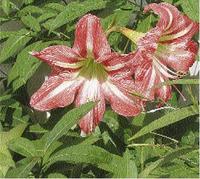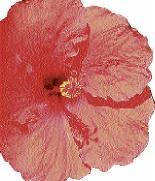

Amaryllis
Bianca, a friend of mine, has four 'Christmas' amaryllis that she planted at two-week intervals to extend the bloom period. They all did quite well, each producing two 40-centimetre stalks with four to six blooms each. The blossoms are starting to wilt now. My friend asked: "Should I cut off the stems after the blossoms fade? Do amaryllis bloom only once per year?"
I reminded her that amaryllis will only produce one flush of flowering stems per year. The stems should be cut down when the flowers fade, but the foliage should remain until it withers and dies back on its own (a rule of thumb for bulbous plants).
Guidelines for care
If the flowers are wilting prematurely it might indicate that bulbs were stored in inadequate conditions, did not get enough light, or received too much water.
Here are some general guidelines for coaxing the bulbs to bloom again next year: Amaryllis bulbs grow best in bright light at temperatures of 60-70°F. Place bulbs in soil so that the top half of the bulb is exposed. It is important to remember that half the bulb should remain above soil surface.
The flower stalk will emerge first, followed by two or more leaves. After flowering, cut off the stalk but, as mentioned above, allow the leaves to remain. Keep the soil moist, but not soggy.
If you are dealing with potted amaryllis, in the spring place the pot outdoors in a shady place. In late summer, when the leaves turn yellow and die, stop watering, bring the plant indoors, and allow it to rest in a cool, dry place for about three months. Around the first of December, repot the bulb in fresh soil and place it in a bright room. Begin watering again and a new flower stalk and new leaves will emerge from the bulbs, beginning the process anew.
African violetsAfrican violets are easy to grow, and satisfying, because they are so free-flowering. They don't need any special lighting - a little filtered early morning light is sufficient. Here are a few tips:
Use small pots - they flower best when they are slightly root-bound.
Set them in a saucer filled with pebbles and water for humidity. The water shouldn't actually touch the bottom of the plants.
Don't mist the plants - this causes unsightly leaf spots that are an entry point for disease.
Use a special African violet potting soil and feed with African violet food or an acid plant food.
Water from the bottom to avoid water spots on the leaves.
Zinnia seed grown in pot
Zinnias
Want a fun idea with quick results? Buy a packet of zinnia seeds and sow them tightly in a medium-size pot filled with rich earth. Cover with a thin layer of soil to protect from greedy birds. Place in a sunny location visible from the house, or close to your entrance door. You want to be able to admire the colourful show that zinnias will put up in a couple of months.
Zinnias were introduced in Jamaica in 1772, by Hinton East.
Pruning hibiscus
Hibiscus - Photos by Rita Elliot
Hibiscus may be cut back in late winter or very early spring before the new growth begins. Remove any crossing branches, dead wood, and broken limbs. Then trim to shape as needed. The plant can also be renewed by cutting it back very hard.
The amount to prune is a matter of personal taste; the bush can be left to grow into a small tree, or sheared as one would a hedge. It blooms on new wood of the season, so should not be pruned when in active growth, as this will remove flowering wood.

